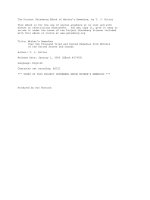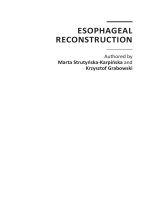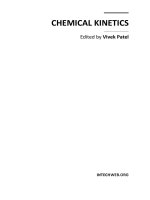Tài liệu Chemical Kinetics Edited by Vivek Patel potx
Bạn đang xem bản rút gọn của tài liệu. Xem và tải ngay bản đầy đủ của tài liệu tại đây (12.68 MB, 354 trang )
CHEMICAL KINETICS
Edited by Vivek Patel
Chemical Kinetics
Edited by Vivek Patel
Published by InTech
Janeza Trdine 9, 51000 Rijeka, Croatia
Copyright © 2012 InTech
All chapters are Open Access distributed under the Creative Commons Attribution 3.0
license, which allows users to download, copy and build upon published articles even for
commercial purposes, as long as the author and publisher are properly credited, which
ensures maximum dissemination and a wider impact of our publications. After this work
has been published by InTech, authors have the right to republish it, in whole or part, in
any publication of which they are the author, and to make other personal use of the
work. Any republication, referencing or personal use of the work must explicitly identify
the original source.
As for readers, this license allows users to download, copy and build upon published
chapters even for commercial purposes, as long as the author and publisher are properly
credited, which ensures maximum dissemination and a wider impact of our publications.
Notice
Statements and opinions expressed in the chapters are these of the individual contributors
and not necessarily those of the editors or publisher. No responsibility is accepted for the
accuracy of information contained in the published chapters. The publisher assumes no
responsibility for any damage or injury to persons or property arising out of the use of any
materials, instructions, methods or ideas contained in the book.
Publishing Process Manager Daria Nahtigal
Technical Editor Teodora Smiljanic
Cover Designer InTech Design Team
First published February, 2012
Printed in Croatia
A free online edition of this book is available at www.intechopen.com
Additional hard copies can be obtained from
Chemical Kinetics, Edited by Vivek Patel
p. cm.
ISBN 978-953-51-0132-1
Contents
Preface IX
Part 1 Introduction to Chemical Kinetics 1
Chapter 1 Chemical Kinetics, an Historical Introduction 3
Stefano Zambelli
Part 2 Chemical Kinetics and Mechanism 29
Chapter 2 On the Interrelations Between
Kinetics and Thermodynamics as
the Theories of Trajectories and States 31
Boris M. Kaganovich, Alexandre V. Keiko,
Vitaly A. Shamansky and Maxim S. Zarodnyuk
Chapter 3 Chemical Kinetics and Inverse Modelling Problems 61
Victor Martinez-Luaces
Chapter 4 Model Reduction
Techniques for Chemical Mechanisms 79
Terese Løvås
Chapter 5 Vibrational and Chemical
Kinetics in Non-Equilibrium Gas Flows 115
E. V. Kustova and E. A. Nagnibeda
Chapter 6 Numerical Analysis of the Effect
of Inhomogeneous Pre-Mixture on
Pressure Rise Rate in HCCI Engine by
Using Multi-Zone Chemical Kinetics 141
Ock Taeck Lim and Norimasa Iida
Chapter 7 Ignition Process in a
Non-Homogeneous Mixture 155
Hiroshi Kawanabe
VI Contents
Part 3 Chemical Kinetics and Phases 167
Chapter 8 Chemical Kinetics in Cold Plasmas 169
Ruggero Barni and Claudia Riccardi
Chapter 9 Chemical Kinetics in Air
Plasmas at Atmospheric Pressure 185
Claudia Riccardi and Ruggero Barni
Chapter 10 The Chemical Kinetics of
Shape Determination in Plants 203
David M. Holloway
Chapter 11 Plasma-Chemical Kinetics of Film
Deposition in Argon-Methane and Argon-Acetylene
Mixtures Under Atmospheric Pressure Conditions 227
Ramasamy Pothiraja, Nikita Bibinov and Peter Awakowicz
Part 4 Recent Developments 167
Chapter 12 Recent Developments on the
Mechanism and Kinetics of Esterification
Reaction Promoted by Various Catalysts 255
Zuoxiang Zeng, Li Cui, Weilan Xue, Jing Chen and Yu Che
Chapter 13 Progresses in Experimental Study of N
2
Plasma
Diagnostics by Optical Emission Spectroscopy 283
Hiroshi Akatsuka
Chapter 14 Nanoscale Liquid is Second Liquid 309
Boris A. Mosienko
Part 5 Application of Chemical Kinetics 323
Chapter 15 Application of Catalysts to Metal Microreactor Systems 325
Pfeifer Peter
Preface
Chemical kinetics, also known as reaction kinetics, is the study of rates of chemical
processes and mechanism of chemical reactions as well, effect of various variables,
including from re-arrangement of atoms, formation of intermediates, etc. Students,
researchers, research scholars, scientists, chemists and industry fraternity needs to
understand chemical kinetics so that industrial reactions can be controlled, and their
mechanisms understood. Chemical kinetics also provide an idea to make predictions
about important reactions such as those that occur between gases in the atmosphere. It
is a huge field that encompasses many aspects of physical chemistry.
The book is designed to help the reader, particularly students, researchers, research
scholars, scientists, chemists and industry fraternity of chemistry and allied fields;
understand the mechanics and reactions rates. The selection of topics addressed and
the examples, tables and graphs used to illustrate them are governed, to a large extent,
by the fact that this book is aimed primarily at chemistry and allied science and
engineering technologist.
The objective of this book is to give academia, research scientists, research scholars,
science and engineering students and industry professionals an overview of the
kinetics quantities such as rates, rate constants, enthalpies, entropies, and volume of
activation. This book also emphasizes how these factors are used in interpretation of
the mechanism of a reaction.
This book is based on the series of chapters written by different authors and divided
into 15 chapters, each one succinctly dealing with a specific chemical kinetics and
reaction mechanisms. The contents are widely encompassing as possible for chemical
kinetic research field.
The book critically compares the chemical kinetics and reaction mechanisms so that
the most attractive options for chemistry (physical, organic and inorganic) research
can be identified for academia, research scientists, research scholars, science and
engineering students and industry professionals.
Dr. Vivek Patel, SKO
Centre for Knowledge Management of Nanoscience & Technology (CKMNT),
Vijayapuri Colony, Tarnaka, Secunderabad,
India
Part 1
Introduction to Chemical Kinetics
1
Chemical Kinetics, an Historical Introduction
Stefano Zambelli
University of Padova,
Italy
1. Introduction
This Chapter would provide a methodological analysis of the historical developments of
chemical kinetics from the beginnings to the achievements of Transition state theory and
Kramers-Christiansen approach. Chemical kinetics is often treated as a side issue of the
most important disciplines of chemical science. Students in most of the cases gain
knowledge of Kinetics as part of Physical Chemistry introductory courses and find it again
applied in many other contests.
Despite that, it would necessitate a fundamental and main teaching course as we will see in
the course of this chapter. This didactical and academic approach could have many reasons.
A general one may be the philosophical and psychological disposition to put our attention
more on objects rather than concepts, matter over processes.
In Science History there are many examples of this tendency: the transmission of heat and
electromagnetic waves are good examples. Phlogiston and Luminiferous Aether represents
a materialization of processes that processes themselves do not need to be studied, however
our mind need this primitive objectivization to grasp the concept in a simpler way.
This represents a fundamental issue of scientific method: to do Science we need to go
beyond banality and perception. The development of Chemical Kinetics is deeply involved
in the counterfactual approach that brought from Alchemy to Chemistry as for Physics form
Aristotelic Natural Philosophy to Galilean Science.
2. Origins of chemical kinetics: The declinations of affinity
The chemical affinity principle, developed during the seventeenth century, derives from the
alchemical concept of chemical wedding: similar substances will interact so we can
categorize them. The real innovation at the end of 17
th
and during the 18
th
centuries was the
application of that concept not only as a taxonomic principle but also for the comprehension
of chemical reactivity.
The interaction of bodies is simpler when there is a similitude between them, this is the base
idea of Chemical Affinities and come from ancient and medieval alchemy and naturalism
doctrine. At the end of 17
th
century this intuitive principle become a theory, although
qualitative, that justify and classify interactions between different substances.
In the same period also the observation of time become important for the determination of
the nature of chemical reactions. Time of decurrence was clearly contemplated for the
Chemical Kinetics
4
preparation of substances with long reactions but it was seen as an ordinary technical factor.
The Opera of Alchemy, for example in the transmutations of metals, was considered as a
means for the acceleration of the millenary gestation of precious metals in the bowels of
Earth Mother. The underestimate of real times in the alchemists conceptions resulted so
natural in an activity that already theoretically reduced geological times. The paradox was
that time, a fundamental principle for alchemic theory, resulted of little importance in the
alchemical praxis.
Probably the first scholar that introduced a dynamical vision of the chemical phenomena
was Wilhelm Homberg (1652-1715). Homberg, a German scholar, worked in Magdeburg
with Von Guericke, in Italy and later in England with Boyle. He introduced the first
principles of quantitative measurement for chemical action: the strength of an acid towards
a series of alkali depends on the time of neutralization of the various alkali.
2.1 Tabulae affinitatum
The lists of strength of alkali and the concept of chemical affinity brought Etienne Francois
Geoffroy (1672-1731), a French scholar initiated to chemistry by Homberg himself, to the
compilation of the Tables of Affinity, (or Tables of Rapports) that could be considered as the
first ancestor of the periodic table. The first one was done by Geffroy (Geoffroy, 1718). You
can see the Encyclopédie version in the following figure.
Fig. 1. Recueil de Planches, sur les Sciences, les Arts Libéraux, et les Arts Méchaniques, 1772
Chemical Kinetics, an Historical Introduction
5
In the first row you can see the primary substances then going down along the columns the
similar substances in order of affinity with the first one.
The development of Affinity tables was inevitably considered in the light of the main
scientific discussion of the 18
th
century: the debate between plenistic Cartesian vision and
the Newtonian distance action principle. Important chemisters of this period took parts in
that debate: Boerhaave and later Buffon among Newtonian side identified affinities as a
special form of gravitational attraction, Stahl on the other side negated the distance action
invoking the medium of Phlogiston.
Guyton de Morveau (1737-1816), a French scholar, sustained initially phlogiston theory, but
leaved it after in favor of a distance action between the different elementary particles of
substances bringing the chemical affinities to a microscopic level, a similar position was
taken by Berthollet and Lavoisier. De Morveau classified the kind of affinities: simple or by
aggregation, composed, decomposed, double, reciprocal, intermediate, dispositional. He
listed also the laws of affinity:
- Molecules have to be in fluid state to respond to affinities influence.
- Affinities acts between the elementary particles of bodies.
- Affinities between two different substances may be different from that between their
composites.
- Affinity of substances acts only if it is bigger than the aggregation affinity of
themselves.
- Two or more bodies united by affinity form a new body with different properties from
precursors.
- Affinities action and velocity depends on temperature.
Basilar principles of Chemical Kinetics and Chemistry are going to take form. Of particular
importance the last law: temperature and so ambient conditions have influence on chemical
reactivity.
The position of Torben Olof Bergman (1735-1784), a Swedish scholar, about the influence of
temperature is particularly interesting. He assumed the affinity constant at constant
temperature and suggested to compile different affinity tables depending on conditions: the
affinities of dry phase is different from that in liquid phase.
Bergman closed elegantly the debate on the nature of the affinities assuming a very wise
position: it is not useful debating about the last nature of interacting forces between
chemical particles because it will remain unknown until quantitative experiments will be
done on affinities. Bergman so is the first scholar that made some hypothesis about a
measure of the affinities, but their mathematical expressions and measures will be a duty for
future researchers. Bergman compiled also affinity diagrams in his major opera, the
Opuscula. They are an interesting representation of chemical reactions done with alchemical
symbols: the ancestors of stoichiometric equations (although the very first one appeared
even in 1615, but not systematically, in the famous Tyrocinium Chymicum, the first
Textbook of Chemistry written by Jean Beguin). You can see an example in the figure 2. The
diagram represents the reactions of sulfuric and hydrochloric acid with calcium carbonate
and potassium hydroxide (Vitriolic and Marine for acids, Pure calcareous earth and Pure
fixed vegetable alkali for the basis).
Chemical Kinetics
6
Fig. 2. This Affinity Diagram schematize two acid-base reactions
3. Chemical equilibrium conception: The law of mass action
The end of 18
th
Century and the first half of 19
th
added other essential pieces to the puzzle of
Chemical Kinetics and Chemistry in general. There is a surprising absent actor in the debate
on Chemical Affinities, the father of modern Chemistry: Antoine-Laurent de Lavoisier
(1743-1794). The Lavoisier Revolution brought quantitative measurements to Chemistry and
so to Affinity Diagrams. We can see one of the first examples of stoichiometric equation
from Lavoisier works in the following figure (Lavoisier 1782).
Fig. 3. Stoichimetric Equations with Lavoisier’s symbols
Those symbolic equations represent one of the passages of the oxidation of iron in nitric acid
where Mars symbolize iron, the nabla water, the crossed circle oxygen, the triangle and
cross nitrogen oxide. In this passage iron gains the same part of oxygen that nitric acid loses,
an example of the Law of Mass Conservation.
Why Lavoisier did not play a role in the debate about Affinities if he applied quantitative
methods also for affinity diagrams? The causes may be many, for example the fact that he
was outside main academic circles, (he was member of the French Academy of Sciences
from the age of 25, but never gained an academic position). The reasons are explained by
Lavoisier himself in the Traité élémentaire de chimie, and follow Bergan recommendations:
In this writing I followed the principle of not arguing beyond experimentations, not taking over the
silence of facts. So I cannot consider those parts of Chemistry that would probably become Exact
Science before the others. Scholars as Bergman, Scheele, de Morveau and many others are conducting
numerous studies about Chemical Affinities and Attractions, but basic, precise and general data are
lacking at the moment. Affinities theory respect to ordinary Chemistry is as Transcendent Geometry
respect to Elementary one and goes over the scope of this introductory book. Mr de Morveau is
writing the voice Affinity in the Encyclopédie and I am worried to compete with him.
Chemical Kinetics, an Historical Introduction
7
3.1 Characterising of chemical reactions
With the development of Lavoisier’s methods in the second half of the 18
th
Century new
definitions and properties are established. A concept that for today scientists results obvious
was defined: the concentration of substances. The fist timid attempts to distinguish
reactivity and equilibrium was made, for example sulphuric acid was considered the most
powerful because it shifted other acids from their salts, the most strong because it absorbs
most water, the least active because Oleum needs water or hydrated compounds to take
effect. The researches about the reactions between acids and metals are of particular interest
in this period. For example many scholars did not consider more metals as primary
substances thinking they was compounds with an alkaline parts (it will need nearly a
Century for the comprehension of redox reactions).
In the work of Carl Friedrich Wenzel (1740-1793), a dresden metallurgist, we can find the
first link between reaction velocity and quantity of the reactants. He investigated the
reactions between metals considering the time of dissolution of little metal cylinders inside
dilute acid solutions. Using Buffon theories Wenzel considered the affinity of the acids
inversely proportional to the time of dissolution but considered also the role of the solvent
(water). The velocity of reaction results proportional to the affinity or the strength of the
acid while inversely proportional to the resistance of the solvent. In modern terms reaction
velocity is proportional to concentration. Wenzel made also interesting considerations about
thermal conditions, imposing the same temperature for all the dissolutions to compare them
correctly. Some scholars, Wilhelm Ostwald between the most famous, awarded Wenzel for
the first qualitative definition of the Law of Mass Action, although the primacy is commonly
given to Berthollet.
Count Claude Louis Berthollet (1748-1822), member of Academy of France and founder of
the Ecole Polytechnique, collaborated with Lavoisier but was more lucky than him. He had
no problems during the revolution and got in the good books of Napoleonic government.
He followed Bonaparte’s expedition to Egypt. Visiting the Natron Lakes, Berthollet
observed soda deposits on the surrounding limestone hills. He supposed a chemical reaction
occurring between salt (sodium chloride) and the limestone (calcium carbonate) in the hills
to produce soda (sodium carbonate) and an accompanying product, calcium chloride, which
seeped away into the ground. The reaction was the reverse of the one that chemists knew
under laboratory conditions, and this indicated to Berthollet that physical conditions, such
as heat and pressure, and quantities of reactants could affect the course of a chemical
reaction.
From these and other considerations he exposed the first qualitative form of the Law of
Mass Action during 1803 in two famous publications: “Essai de statique chimique” (fig. 4) e
“Recherches sur les lois des affinités chimiques”. The progress of a chemical reaction depends on
the quantity and conditions of reacting substances. Berthollet’s essays do not relate only on
the velocity of the reaction but also on its equilibrium. Today these considerations may
appear obvious but at the time they received fierce critics.
These theories and the embryonic conception of equilibrium was favourably considered by
some important Chemists as Berzelius, Davy and Gay-Lussac, but most of the scientific
community did not considered them being incompatible with Proust’s and Dalton’s Laws
that monopolized the attention of the scientific community in the period.
Chemical Kinetics
8
Fig. 4. Title and first page of Berthollet Essay
Berthollet made other significant considerations, for example the fact that for solids the
Affinity remain costant. So Affinities are not absolute but become dependant on the
quantities of reactants (except solids), but how those quantities was defined? In the Essai he
defined the Affinity A=a/E , where a is a constant dependant on the substance and E its
equivalent weight. Multiplying the mass of the substance for unit of volume w by the
precedent expression he defined the Active Mass of the reactant equal to the concentration ,
(numbers of equivalent per unit volume: w/E).
The reasons of this rejection depended also by the fact that most of the conclusions of
Berthollet and his predecessors was qualitative and not supported by adequate analytical
data. To get the first quantitative observations and thermodynamic interpretations of
reacting systems we have to wait the second half of 19
th
Century thanks to the development
of analytical chemistry.
3.2 Time: A new quantitative observable
It is difficult today arguing about Chemical Kinetics without Thermodynamic but this
branch of our science was established originally by simple chronological measurements of
chemical processes (King 1981).
The development of quantitative relations and laws derived from the use of advanced
analytical techniques but these did not give real contributions until the end of 19
th
Century
thanks to a suitable mathematical construct.
Initially analytical observations was used to collect a multitude of data from many different
systems thinking in this way to get universal laws in the optic of Natural Philosophy. It is
the passage from the many experiments to the good experiment that made the true change.
Chemical Kinetics, an Historical Introduction
9
The intense experimental phase around the half of 19
th
Century may be efficiently described
by Wilhelmy and Gladstone works.
Ludwig Ferdinand Wilhelmy (1812-1864), a German physicist published in 1850 an
important paper on the kinetic on the inversion of sugar with acids (Wilhelmy, 1850, Fig. 5).
Fig. 5. Wilhelmy paper Title page
He used a new technique, Polarimetry, for evaluating the dependence of reaction velocity
on the quantity of reactants and temperature. In this paper probably appeared the first
differential equation used in chemistry:
dZ
M
ZS
dt
(1)
Reaction velocity is the negative derivative of the sugar quantity
Z in time t, S the acid
quantity and
M the quantity of inverted sugar in the infinitesimal time dt. Considering an
excess of acid
S is constant and supposing also M constant the solution results:
0
M
St
ZZe
(2)
Wilhelmy verified that
M remains almost constant in time and observed the dependance of
that constant with temperature.
Wilhemly’s paper results impressive for its anticipations, it was written forty years before
Arrhenius work on the same topic. Unfortunately, although written in a prestigious Journal,
(the
Poggendorffs Annalen der Physik und Chemie, later Annalen der Physik), the paper passed
unnoticed by contemporary scholars. It will be rediscovered only in 1884 by Ostwald.
Chemical Kinetics
10
Not only Polarimetry but also other techniques useful for kinetic studies was developed in
this period. Colorimetric titrations was used by John Hall Gladstone (1827-1902), Fullerian
Professor of Chemistry in London, to get precise measurements of equilibrium and to
investigate the effect of salts on reaction dynamic.
We will quote the conclusions of Gladstone about the action of thiocyanate on iron salts to
notice the evolution of the language and concepts on the topic (Gladstone, 1855):
1. Where two or more binary compounds are mixed under such circumstances that all the
resulting bodies are free to act and react, each electro-positive element arrang-es itself in
combination with each electro-negative element in certain constant proportions.
2. These proportions are independent of the manner in which the different elements were
originally combined.
3. These proportions are not merely the resultant of the various strengths of affinity of the
several substances for one another, but are dependent also on the mass of each of tie
substances in the fixture.
4. An alteration in the mass of any one of the binary compounds present alters the amount
of every one of the other binary compounds, and that in a regularly pro- gressive ratio;
sudden transitions only occurring where a substance is present which is capable of
combining with another in more than one proportion.
5. This equilibrium of affinities arranges itself in most cases in an inappreciably short
space of time, but in certain instances the elements do not attain their final state of
combination for hours, or even days.
6. The phenomena that present themselves where precipitation, volatilization,
crystallization, and perhaps other actions occur, are of an opposite character, simply
because one of the substances is thus removed from the field of action, and the equi-
librium that was first established is thus destroyed.
7. There is consequently a fundamental error in all attempts to determine the relative
strength of affinity by precipitation; in all methods of quantitative analysis founded on
the colour of a solution in which colourless salts are also present; and in all conclusions
as to what compounds exist in a solution drawn from such empirical rules as that " the
strongest base combines with the strongest acid."
From Gladstone experiments Chemists on the field begun to use extensively optical
methods verifying Berthollet’s statements and two facts emerged clearly: the presence of the
equilibrium conditions in contrast with Proust’s Law, the hypothetical achieving of a
complete reaction after an infinite time.
4. Clockwork stoichiometry
We will see that many exemplary experiments survived the second half of 19
th
Century and
results still dominating in chemical didactics. The acid esterification of alcohols is
emblematic in this sense: it is difficult nowadays to find an introductory textbook that does
not explain this reaction as basic example.
In most of cases nevertheless the origin of that example is not cited. It comes from a series of
experiments done by a couple of Parisian chemists around the 1860: Pierre Eugene Marcelin
Berthelot (1827-1907) and Leon Peon de Saint-Gilles (1832-1863), the first one full professor
of chemistry at the Ecole de Pharmacie, the second a wealthy dilettante.
Chemical Kinetics, an Historical Introduction
11
Their work (Berthelot & Saint Gilles, 1862) will be extensively used by other two important
couples of scholars: Guldberg and Waage, Harcourt and Esson. We will speak of them later
in the chapter. In the title they referred to etherification but in the paper they speak about
esterification, probably a misprint.
Arising from his interest in esterification, Berthelot studied the kinetics of reversible
reactions. Working with Saint Gilles, he produced an equation for the reaction velocity
depending on reactants concentrations. This was incorrect because they did not considered
in the expression the inverse reaction. Other interesting considerations was the hypothesis
of an exponential dependence on temperature and the fact that equilibrium position is
independent from the kind of alcohols and acids used.
The conclusions of Berthelot and Sait Gilles was not particularly new compared to those of
Wilhelmy. They found similar expressions and both esterification and sugar inversion are
good systems for the study of kinetic and equilibrium. May be that the use of differential
equations was not usual for the chemists at the time. Significantly Guldberg and Esson was
mathematicians that helped later the chemists Waage and Harcourt.
The fact that chemists used mathematics so late after decades of data collections may
surprise the actual reader, but we have to consider that a systematic study of mathematics
was not considered in chemistry courses until after the second world war. This delay did
not regarded only Chemical Kinetics but chemistry in general. We have to wait Physical
Chemistry, other developments in Analytical Chemistry and a general evolution of
Chemistry equipment and instruments to free chemists from very difficult and hard-
working experimental praxis for the development of theoretical reflections and laws.
4.1 The law of mass action again
The first quantitative expression of the law of mass action was presented by Cato
Maximilian Guldberg (1833-1902) and Peter Waage (1839-1900) two years later (Guldberg
& Waage, 1864). They was Norwegian Professors of Mathematics and Chemistry at the
Christiania University of Oslo and brothers in law (fig. 6).
It is interesting to consider the blessed situation of chemistry in Scandinavia coming from
the necessities of mining industry and from the large number of eminent chemists like
Scheele, Bergman, Berzelius, the same Guldberg and Waage, Arrhenius and Nobel later.
Scandinavian insulation and advanced knowledge promoted many autonomous researches
and caused often independent contemporary discoveries with other European groups.
Despite being isolated as the use of the Laurent-Gherard notation demonstrate, (that
notation was diffused more than ten years before ), from 1862 and 1864 they repeated and
examined experiments and results of Berthelot and Saint Gilles on esterification, Rose’s
work on Barium salts and that of Scherer on heterogeneous reaction between silica and
soda. The study of so different processes derived from the will of the authors to get a new
law, universal for all chemical processes. The style of the 1864 paper was polemical
against the precedent theories of affinity that the authors considered inconclusive or
erroneous.
Chemical Kinetics
12
Fig. 6. Guldberg & Waage
Guldberg and Waage preferred a less speculative and more direct approach simply
enunciating the formula for the definition of action of mass and volume:
ab
chem
M
N
F
VV
(3)
Where
F
chem
represents the chemical force, M and N the quantity of the reacting substances,
V the volume, α, a and b constants wich, other conditions being equal, depends only from
the nature of the substances. If one begins with a general system containing four active
substances pairwise interacting, (direct and opposite reactions between two reactants and
two products), and considering the balance of chemical forces Guldberg and Waage
obtained the expression for chemical equilibrium:
''
'' '
ab a b
p
x
q
x
p
x
q
x
(4)
where p, q, p’, q’ are the initial concentrations of reactants and products, x the amount of
transformed reactants at equilibrium reaching, α, a, b, α’, a’, b’, constants with the previous
meaning that can be calculated from the initial concentrations, the amount x and
experimental data.
We can quote a passage of the 1864 paper because it resolves the apparent contradiction
between affinities and equilibrium theories towards Proust’s and Dalton’s Laws.
Chemical Kinetics, an Historical Introduction
13
That a chemical process, as so often is the case in chemistry, seems to occur in only one
direction, so that either complete or no substitution takes place, arises easily from our
formula. Since the active forces do not increase proportionally to the masses, but according
to a power of the same, the relationship of the exponent does not have to be particularly
large before the unchanged or changed amount becomes so small that it does not let itself be
revealed by our usual analytical methods.
Timidly in this paper and in the following works of the two scientists there is the
consciousness that the expressions derives from microscopic processes between atoms and
molecules. They present a progressive clarification and distinction of the concept of
chemical forces, initially considered in a Newtonian way to get the balance-equilibrium
expression and in their last paper (Guldberg & Waage, 1879) assimilated to bond strength
and reaction velocity, the macroscopic kinetic observable.
In this last work are present many interesting intuitions, there is an hypothesis of the
microscopic interaction mechanism and from that and the stoichiometric coefficients a try to
explain theoretically the exponential coefficients, previously arbitrary or purely
phenomenological and there is a mild use of thermodynamic data.
Guldberg and Waage went a step further in the correct direction introducing suitable
formulas for equilibrium and velocity expressions but do not have the theoretical
instruments to justify and interpret it correctly. They examined a huge number of different
chemical systems falling in the old trap of getting general laws from the many experiments
rather than the good experiment.
5. Thermodynamics revolution
The first non systematic introduction of thermodynamics in Chemical Kinetics is due to the
second couple of scientists previously cited:
Augustus George Vernon Harcourt (1834-1919)
and
William Esson (1839-1916). Harcourt was an important chemist, member of the Royal
society and president of Chemical society, Esson a mathematician and Savilian professor of
Geometry. They worked at University of Oxford in a period particularly fruitful for Sciences
in Britain. It is the peak of positivism and at the time different sciences, included chemistry,
got clearly distinct university courses. Their activity covered a period of fifty years and
represented the main passage from natural philosophy speculations to modern scientific
reasoning. Influenced by Van’t Hoff they will definitively abandon ambiguous terms like
Affinity and Chemical Forces.
In 1864 Harcourt presented his first publications contemporary to Guldberg and Waage
paper. In this work only the name of Harcourt appears but Esson asked the collaboration of
a chemist around six years before to applying his mathematical methods to experimental
chemistry. In 1865 it was Harcourt that asked Esson to collaborate and their partnership will
continue for the rest of their lives (Harcourt & Esson 1865).
In the first part of their studies they searched chemical processes suitable for kinetics
measurements. Harcourt found an initial valid system: the oxidation of oxalic acid with
potassium permanganate. He supposed a two step mechanism:
1.
K
2
Mn
2
O
8
+3MnSO
4
+H
2
O=K
2
SO
4
+2H
2
SO
4
+5MnO
2
2.
MnO
2
+ H
2
SO
4
+ H
2
C
2
O
4
= MnSO
4
+2CO
2
+2H
2
O
Chemical Kinetics
14
Verifying it, like today, by the presence of the intermediate manganese oxide and by the
acceleration of reaction if manganese sulphate was present at the beginning of the reaction.
Examining again the data around 1866 with Esson they plotted a curve of time vs quantity
of reactants verifying a logarithmic trend.
To get a better plot they needed to interrupt the reaction at will and to analyze the quantity
of substances reacted at time of interruption. So they considered another reaction: the
oxidation of hydroiodic acid with hydrogen peroxide in presence of definite quantities of
thiosulfate and a starch indicator. They measured the time passed before the appearance of
blue solutions after the consumption of thiosulfate. In this way they confirmed precisely the
logarithmic trend and published their results (Harcourt & Esson, 1867).
They extended also an interesting comparison about the energetic of chemical processes. A
chemical reaction is like the fall of bodies: the initial activity of reactants is converted in
reaction transformation as the potential energy of a falling body in kinetic energy. Reaction
velocity so does not remain constant depending on reactants activity. To get a function of
velocity they need to consider an infinitesimal time interval introducing, again in analogy
with Mechanics, an instantaneous reaction velocity.
The velocity of change, equal to the negative time derivative of reactants quantity, is
assumed to be proportional to their original quantity y and a constant a depending on the
considered system:
dy
ay
dt
(5)
Results and methods of this system was published again and better described in other two
important papers: the Bakerian Lecture (Harcourt & Esson, 1895) and the last paper written
by the authors Harcourt & Esson, 1912, fig. 7).
These publications represents probably the most important works for the beginning of
modern Chemical Kinetics. They introduced the today common symbol for reaction rate
constant k and evaluated formally its dependence on temperature.
There is a clear conception of the microscopic nature of chemical processes, they supposed
for example that rate constant nullifies at absolute zero, considering that inert atoms and
molecules could not encounter and interact each other.
To describe temperature dependence of rate constant we will consider the theoretical
explanation done by Esson from the experimental ratio between two rate constants at
different temperatures found by Harcourt:
''
m
kT
kT
(6)
Where k, k’ are the rate constants, T, T’ the absolute temperatures and m an experimental
pure number. Expressing the equation (6) in differential form m becomes a proportionality
constant of infinitesimal changes of the temperatures and rate constants:
dk dT
m
kT
(7)
Chemical Kinetics, an Historical Introduction
15
Fig. 7. Front page of the Phil. Trans. volume with the last paper of Harcourt and Esson
The value of m resulted constant for all temperatures, depending only on the chemical
system considered. Considering a big excess of one reactant its chemical activity, (Esson
used the term potential but we will use activity to avoid confusion with chemical potential
µ), may be supposed constant during reaction course because its quantity remain nearly the
same, so the variation in rate constant may be caused only by temperature variation (the
precedent argumentation for equation (5) is difficult to use in this case).
In this conditions Esson talk about stable conversion of thermal energy to chemical energy
with m a constant of proportionality between the different energies. Reconsidering equation
(5) and integrating we can obtain an expression for chemical potential energy, (in Esson’s
terms), whose variation remain constant for the same variation of reactant concentration at
different temperatures:
21 2 1
() () '() '() ''
f
yfyfyfyktkt
(8)
Where the terms with asterisk derives from a reaction at temperature T’. From (6), (7) and
(8) equations we can obtain the following expression:
'
''
m
kt T
kt T
(9)









